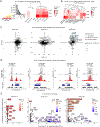Epigenetic dysregulation in Alzheimer's disease peripheral immunity
- PMID: 38340719
- PMCID: PMC11031321
- DOI: 10.1016/j.neuron.2024.01.013
Epigenetic dysregulation in Alzheimer's disease peripheral immunity
Abstract
The peripheral immune system in Alzheimer's disease (AD) has not been thoroughly studied with modern sequencing methods. To investigate epigenetic and transcriptional alterations to the AD peripheral immune system, we used single-cell sequencing strategies, including assay for transposase-accessible chromatin and RNA sequencing. We reveal a striking amount of open chromatin in peripheral immune cells in AD. In CD8 T cells, we uncover a cis-regulatory DNA element co-accessible with the CXC motif chemokine receptor 3 gene promoter. In monocytes, we identify a novel AD-specific RELA transcription factor binding site adjacent to an open chromatin region in the nuclear factor kappa B subunit 2 gene. We also demonstrate apolipoprotein E genotype-dependent epigenetic changes in monocytes. Surprisingly, we also identify differentially accessible chromatin regions in genes associated with sporadic AD risk. Our findings provide novel insights into the complex relationship between epigenetics and genetic risk factors in AD peripheral immunity.
Keywords: Alzheimer's disease; T cells; bioinformatics; chromatin; epigenetics; immunity; monocytes; single-cell ATAC-seq; single-cell RNA sequencing; transcriptomics.
Copyright © 2024 Elsevier Inc. All rights reserved.
Conflict of interest statement
Declaration of interests D.G. is an inventor on a patent related to this work. Patent US-2022-0170908-A1 is for compositions and methods for measuring T cell markers associated with AD.
Figures






References
-
- Grupe A, Abraham R, Li Y, Rowland C, Hollingworth P, Morgan A, Jehu L, Segurado R, Stone D, Schadt E, et al. (2007). Evidence for novel susceptibility genes for late-onset Alzheimer’s disease from a genome-wide association study of putative functional variants. Hum Mol Genet 16, 865–873. 10.1093/hmg/ddm031. - DOI - PubMed
MeSH terms
Substances
Grants and funding
LinkOut - more resources
Full Text Sources
Medical
Molecular Biology Databases
Research Materials

